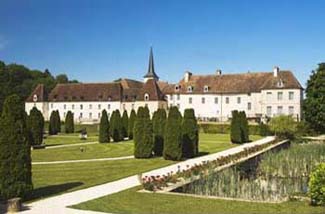
Photos courtesy of Château de Gilly
Gilly-les-Cîteaux
21640 Vougeot
Tel: ++33 (0) 3 80 62 89 98
Hotel website
48 rooms
Double rooms: 130–319 euros
Suites: 285–559 euros
Open: all year
The château is halfway between Beaune and Dijon—just off highway D974. From Beaune, take A31 towards Dijon; exit Nuits St George and follow signs to Gilly-les-Cîteaux. Nearest train station is at Dijon—15 km.
On site: spa; tennis; billiards;
swimming pool (summer)
Nearby: wine tasting; golf; hot-air ballooning; Dijon
Superbly located in the heart of the Bordeaux wine region between Beaune and Dijon, the Château de Gilly enjoys lovely gardens and a friendly staff.
When approaching the château the first thing you’ll notice is the web of moats, which have origins in the 6th century. Interiors of the main building are embellished by rich tapestries on old stone walls and suits of armor. Ceilings can be painted or vaulted.
Guest rooms fall into six categories and are located in either the main house or in two adjoining pavilions—the Pavillon du Pere Abbé or the Pavillon des Jours. All have views of the gardens, and a few have views of the village or Vourge River. One suite features a stone fireplace, and another rich wood paneling. Room decor is traditional French floral.
An underground passageway leads to the formal Clos Prieur restaurant. Originally the wine cellar for the Cistercian monks, today it’s a fantastic setting for an elegant dinner, among slender pillars that support a rib-vaulted ceiling. No less than 15,000 bottles fill the château’s cellars.
During the summer months lunch can be enjoyed outside on a shaded, flower-filled terrace.
![]() Classified as a monument historique
Classified as a monument historique